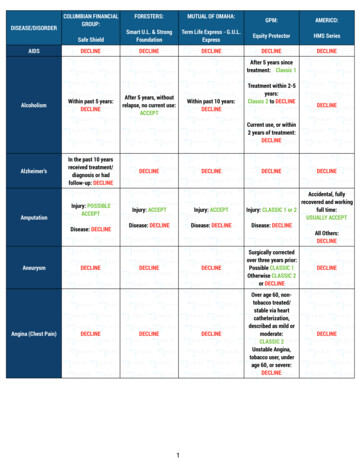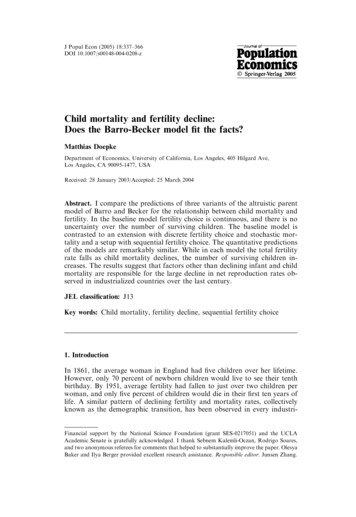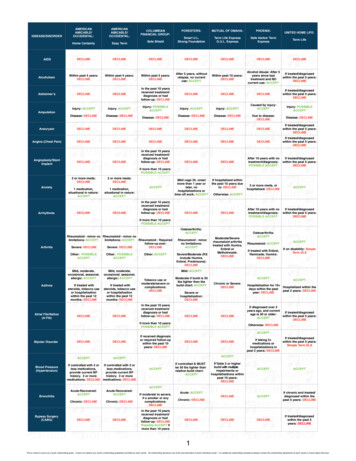
Transcription
Evolutionary Psychologywww.epjournal.net – 2007. 5(3): 584-604 Original ArticleThe functional design of depression’s influence on attention: A preliminarytest of alternative control-process mechanismsPaul W. Andrews, Virginia Institute for Psychiatric and Behavioral Genetics (VIPBG), VirginiaCommonwealth University, Richmond, VA, USA. Email: pandrews@vcu.edu (Corresponding author)Steven H. Aggen, VIPBG, Virginia Commonwealth University, Richmond, VA, USAGeoffrey F. Miller, Psychology Department, University of New Mexico, Albuquerque, NM, USAChristopher Radi, Psychology Department, University of New Mexico, Albuquerque, NM, USAJohn E. Dencoff, Psychology Department, University of New Mexico, Albuquerque, NM, USAMichael C. Neale, VIPBG, Virginia Commonwealth University, Richmond, VA, USAAbstract: Substantial evidence indicates that depression focuses attention on the problemsthat caused the episode, so much that it interferes with the ability to focus on other things.We hypothesized that depression evolved as a response to important, complex problemsthat could only be solved, if they could be solved at all, with an attentional state that washighly focused for sustained periods. Under this hypothesis, depression promotes analysisand problem-solving by focusing attention on the problem and reducing distractibility. Thispredicts that attentionally demanding problems will elicit depressed affect in subjects. Wealso propose two control-process mechanisms by which depression could focus attentionand reduce distractibility. Under these mechanisms, depression exerts a force on attentionlike that of a spring when it is pulled or like a magnet on a steel ball. These mechanismsmake different predictions about how depressed people respond emotionally to a task thatpulls attention away from their problems. We tested these predictions in a sample of 115undergraduate students. Consistent with our main prediction, initially non-depressedsubjects experienced an increase in their depressed affect when exposed to an attentionallydemanding task. Moreover, the overall pattern of results supported the magnet metaphor.Keywords: analytical reasoning, attention, control-process mechanisms, depression,emotion, evolution, functional design.
The functional design of depression’s influence on attentionIntroductionOrganisms face multiple adaptive challenges, many of them simultaneously, andthey must have adaptations that allocate attention and cognitive resources to them.Negative emotions are thought to have evolved, at least in part, for this purpose(Alexander, 1986; Barlow, 2002; Buss, 2000; Ohman, Flykt, and Esteves, 2001; Thornhilland Thornhill, 1989). Specifically, the effect of negative emotions on attention is thought tobe analogous to the influence of physical pain on attention. Physical pain draws attention toproblems that are causing, or threatening to cause, physical damage to the body, such as thepain that one feels when one inadvertently puts one’s hand on a hot surface (Eccleston andCrombez, 1999; Wall, 2000). Similarly, negative emotions are thought to have evolved todraw attention to important problems in the environment (often of a social nature) that hadan important impact on fitness and could be fixed or ameliorated with attention (Alexander,1986; Thornhill and Thornhill, 1989).Control-process views of emotion suggest that they are related to progress orfrustration in finding solutions to problems or meeting goals (Carver, Lawrence, andScheier, 1996; Carver and Scheier, 1990). Negative emotions are elicited when one has notfound a solution to a problem or one is not making satisfactory progress towards a goal,and the emotion draws attention to the task of finding a solution. Conversely, positiveemotions are elicited when one has found a solution or is making satisfactory progresstowards a goal, and the emotion keeps attention focused on the adaptive course. Forinstance, courtship is emotionally painful when unrequited, and attention is directed tosolving the problem of successfully wooing the desired partner. However, positive emotionis elicited when the partner responds positively to the courtship, and attention and behaviorstays focused on the same course, at least until progress towards the mating goal becomesunsatisfactory. Thus, the valence of emotion reflects whether or not progress towards a goalor a solution is being frustrated (Carver et al., 1996; Carver and Scheier, 1990).There are many different negative emotions—e.g., anger, anxiety, disgust, fear,jealousy—and they presumably evolved to influence attention in different ways. In thispaper, we focus on the attentional function of depression or depressed affect, which is anemotion characterized by negative affect and low arousal.Although clinical depression is often assumed to be qualitatively different thansubclinical forms, explicit tests of this assumption have found that depressed affect is bettercharacterized by a single dimension that varies continuously in intensity and duration(Aggen, Neale, and Kendler, 2005; Krueger and Markon, 2006). For instance, depressivesymptoms vary continuously in epidemiological samples (Hankin, Fraley, Lahey, andWaldman, 2005), and the degree of psychosocial impairment covaries linearly with thenumber of depressive symptoms (Kessler, Zhao, Blazer, and Swartz, 1997; Sakashita,Slade, and Andrews, 2007). We therefore use the terms depressed affect and depression torefer to a single continuum that varies from transient sadness to chronic, severe, clinicaldepression.There is abundant evidence that depression influences attention. People withclinical or subclinical depression tend to report persistent ruminations about importantproblems in their lives (Lyubomirsky, Tucker, Caldwell, and Berg, 1999). Indeed, peopleEvolutionary Psychology – ISSN 1474-7049 – Volume 5(3). 2007.-585-
The functional design of depression’s influence on attentionwith greater levels of depression tend to ruminate more and are less easily distracted fromtheir ruminations (Just and Alloy, 1997; Lam, Smith, Checkley, Rijsdijk, and Sham, 2003;Nolen-Hoeksema and Morrow, 1991; Schmaling, Dimidjian, Katon, and Sullivan, 2002).Attention is a limited resource (Kahneman, 1973), with one implication being that asattention becomes more focused on one problem, fewer cognitive resources are availablefor other problems. Further evidence of depression’s influence on attention thus comesfrom the fact that depressives’ ruminations interfere with their ability to concentrate onother things. For instance, when people come into a psychological testing situation withclinical or subclinical depression, their ruminations interfere with their ability to focus oncognitive tasks and reduce their performance (Lyubomirsky, Kasri, and Zehm, 2003;Watkins and Brown, 2002; Watkins and Teasdale, 2001; Watkins, Teasdale, and Williams,2000). Such research suggests that depression focuses attention on the problems that causedthe episode, so much so that it interferes with people’s ability to focus on other things. Putanother way, one of depression’s effects is to focus attention and reduce distractibility.Depressives’ focused attentional state can affect how they process information.Research on pre-existing and experimentally induced mood indicates that depressed affectpromotes an analytical processing style (Ambady and Gray, 2002; Au, Chan, Wang, andVertinsky, 2003; Bless, Bohner, Schwarz, and Strack, 1990; Bless, Mackie, and Schwarz,1992; Braverman, 2005; Edwards and Weary, 1993; Forgas, 1998; Gasper, 2004; Gasperand Clore, 2002; Hertel, Neuhof, Theuer, and Kerr, 2000; Schwarz and Bless, 1991;Semmler and Brewer, 2002; Sinclair, 1988; Sinclair and Mark, 1995; Storbeck and Clore,2005; Yost and Weary, 1996). Analytical reasoning involves dividing a complex probleminto smaller, more manageable components, where each is studied in turn. To arrive at thesolution to the whole, the solution to each component must be maintained in memory whileprocessing on the next component takes place. Analytical reasoning therefore requires theuse of working memory, which holds information in a highly active state because it iscrucial to ongoing processing (Baddeley, 1996).The Raven’s Advanced Progressive Matrices (RAPM) is considered one of the bestmeasures of nonverbal analytical reasoning ability (Carroll, 1993). Each item is a spatialpattern completion task in which one of eight choices correctly completes a twodimensional visual array, and test items become progressively more difficult. The difficultyof test items increases, in part, because the number of elements in the array increases andthe rules for how they vary across the array can be different for each element (Carpenter,Just, and Shell, 1990). The rule for each element must be ascertained independently, soonce subjects figure out the rule for how one element varies across the array, they mustkeep the solution in their working memory while they figure out the rules for the remainingelements. The number of elements that must be analyzed and held in working memoryvaries from 1 to 5, and the proportion of people getting a test item correct is negativelyrelated to the number of elements that must be analyzed (Carpenter et al., 1990).Current research indicates that analytical tasks with high working memory loads,such as the RAPM, are attentionally demanding because they leave little room for attentionto wander (Kane and Engle, 2002). For instance, performance on the RAPM is highlycorrelated with the ability to resist distractions under attentionally demanding conditions,and the relationship is mediated by differential activity in areas of the brain known to beEvolutionary Psychology – ISSN 1474-7049 – Volume 5(3). 2007.-586-
The functional design of depression’s influence on attentioninvolved in attentional control (Gray, Chabris, and Braver, 2003).In summary, depressed affect focuses attention on problems, and it promotes ananalytical processing style. Because analytical reasoning requires focused attention, itseems reasonable to hypothesize that depressed affect may promote an analyticalprocessing style by its attention-focusing effects.We suggest that depressed affect evolved as a response to important, analyticallychallenging problems that could only be solved, if they could be solved at all, with anattentional state that was highly focused for a sustained period of time (Watson andAndrews, 2002). Under this hypothesis, depressed affect promotes analysis and problemsolving by focusing attention on the problem and reducing distractibility.If depressed affect is a response to analytically challenging problems, then a tasksuch as the RAPM should be able to induce depressed affect in people with low levels ofdepression. Established methods for inducing depressed mood involve having subjectslisten to sad music or watch sad movies, giving them negative feedback about theirperformance on tasks, having them apply self-referent statements to themselves (e.g., “Ifeel a little down today”, “I wish I could be myself, but nobody likes me when I am”)(Seibert and Ellis, 1991), and so on (Westermann, Spies, Stahl, and Hesse, 1996). There isalso substantial evidence that stressful life events can induce depression (Kendler,Karkowski, and Prescott, 1999). While cognitively effortful tasks are often used in methodsthat rely on negative feedback, the feedback is almost always fixed (i.e., even people whoperform well on the task are given negative feedback) (Westermann et al., 1996).Moreover, it is failure itself, and not the nature of the task, that is assumed to elicitdepressed affect. Our prediction that an analytically and attentionally challenging task caninduce depressed affect, and not failure per se, is, to our knowledge, novel and untested.There are two potential control-process mechanisms by which depressed affectcould focus attention and reduce distractibility. First, depressed affect may keep attentionfocused on a problem in a way that is similar to the force exerted by a spring. In thisanalogy, the problem could be thought of as being attached to one end of the spring andattention to the other end. When the spring is compressed and relaxed, attention is focusedon the problem, and the force exerted by the spring is minimized. When the spring ispulled, attention is pulled away from the problem, and the spring’s force increases. Ifdepression’s mode of action is like the force exerted by a spring, then depressed affectshould increase as attention is pulled from a focal problem, which would tend to drawattention back to the problem. Validation of the spring metaphor would suggest that, at thetime of measurement, depressed affect is a marker of the degree to which attention isdiverted from the problem that elicited the episode.Alternatively, depression’s influence on attention could be more like the attractiveforce on a steel ball produced by a magnet. In this analogy, the “magnet” is a difficultproblem (e.g., marital troubles). The attractive force that the problem generates is depressedaffect, and it draws attention to the problem just as the magnetic force draws a steel ball tothe magnet. Since the magnetic force is greatest when the steel ball is closest to the magnet,depressed affect should be greatest when attention is fully focused on the problem, where ittends to keep attention focused. When attention is diverted to some other problem,depressed affect will decrease, just as the attractive force on the steel ball lessens as it isEvolutionary Psychology – ISSN 1474-7049 – Volume 5(3). 2007.-587-
The functional design of depression’s influence on attentionpulled from the magnet. Validation of the magnet metaphor would therefore suggest that, atthe time of measurement, depressed affect is a marker of the degree to which attention isfocused and distractibility is reduced.We stress that the terms magnet and spring are merely metaphors to describe thepossible ways depressed affect could exert force on attention. However, we use thembecause they help describe the different mechanisms of action that we are hypothesizing.According to the hypothesis, depressed affect is a response to analytically andattentionally demanding problems that may take a long time to solve. Consequently, theorganism might occasionally need to interrupt processing to deal with pressing issues thatrequire immediate attention (e.g., predators, important social problems). After the issue hasbeen dealt with, attention must return to the core problem that caused the depressiveepisode. Since attention must be pulled from the core problem to be focused on the pressingissue, processing the pressing problem would be very difficult with a spring-likemechanism because a great deal of force must be expended to keep attention focused there.However, under a magnet-like mechanism, once attention was pulled away from the coreproblem and focused on the pressing problem, less force would be needed to keep it there.Thus, a magnet-like mechanism would be better from an engineering perspective.To test between these two mechanisms, we measured subjects’ level of depressedaffect twice. The first assessment (T1) was a baseline measure to assess the level ofdepression that they brought with them into the laboratory. Since depressed affect iscontinuously distributed in populations, people come into a psychological testing situationwith varying levels of depressed affect unless pre-screening takes place. The causes of theirdepressive symptoms are assumed to reflect important pre-existing life issues, and we referto this as their pre-existing depression.Subjects completed the second assessment (T2) of depressed affect after they hadbeen given intervention—in this case, practice questions from the RAPM. The hypothesisthat depressed affect arises in response to an analytically and attentionally challengingproblem predicts that subjects with low levels of pre-existing depression should experiencean increase after exposure to the intervention. We were concerned that after the subjectshad completed the attentionally demanding intervention, their attention would immediatelyrelax and we would be unable to detect the emotional effect we were looking for when theytook the T2 measure. So we devised the intervention’s effect to be prolonged.The intervention was also designed to get subjects with high levels of pre-existingdepression to pull their attention away from their pre-existing problems. The spring andmagnet mechanisms make different predictions about how they will respond emotionally tothe intervention. According to the spring metaphor, this is like pulling a spring, anddepressed affect should increase. Under the magnet metaphor, however, the intervention islike pulling a steel ball away from a magnet. This should cause the level of depressed affectto decrease just as the magnetic force exerted on the ball decreases.Materials and MethodsParticipantsThe 115 participants were University of New Mexico students recruited fromEvolutionary Psychology – ISSN 1474-7049 – Volume 5(3). 2007.-588-
The functional design of depression’s influence on attentionpsychology courses and participated in exchange for extra credit. The intervention grouphad 65 participants (68% females, SD .47, average age 21.9, SD 4.4), whereas the controlgroup had 50 participants (88% females, SD .33, average age 25.4, SD 10.2). One personin the control group did not provide information about their sex or age.InstrumentsScale for assessing depressed affect. Since our two mood-state measures were to becompleted within a few minutes of each other, we were concerned that subjects mightremember their T1 answers when filling out the scales at T2. Moreover, we wanted to beable to detect subtle changes in affect. No existing instruments were adequate for thesepurposes.To accomplish these goals, we constructed two parallel instruments (forms A andB) from a pool of 26 adjectives designed to assess state depression. The pool wascomposed of 16 negative and 10 positive affect adjectives, with each adjective having onesynonym (i.e., there were 13 sets of synonyms). From each paired synonym set, oneadjective was assigned to each scale so that there were 13 adjectives on each form (e.g.,“sad” was on form A and “blue” was the form B synonym). Each adjective was rated on a9-point Likert scale according to how one was feeling right then (1 extremely inaccurateas a self-description, 9 extremely accurate as a self-description). The construction of twodifferent instruments that were roughly equivalent allowed us to reduce memory effects,and the use of multiple adjectives that were rated on Likert scales (as opposed to checklists)allowed us to detect subtle changes in affect.To test for equivalence, we tested the factor structure of the forms on the controlgroup. All subjects took both forms, counterbalanced for order. We used Mx (Neale, Boker,Xie, and Maes, 2003) to perform a series of latent variable analyses using structuralequation modeling (SEM). In SEM, variables are connected by a series of arrows thatrepresent the presumed direction of causation. The likelihood is the probability of obtainingthe observed data under the assumptions of the model (e.g., a multivariate normaldistribution), and it is influenced by the unknown parameters in the model (e.g., theregression coefficients of the variables connected by arrows). Mx searches through theparameter space for the regression coefficients that maximize the likelihood. The fit of themodel is -2 times the natural logarithm of the likelihood (-2LL). For our latent variablemodels, the latent measure of state depression is assumed to influence the observedmeasure for each adjective, and Mx uses the variance that the observed measures share incommon to estimate the regression coefficients to the latent factor. To our knowledge, thisis the first attempt to use maximum likelihood estimation techniques to test the equivalenceof two instruments for assessing affective states.With maximum likelihood, significance testing is done by calculating the differencein the fits between nested models, -2 LL, which is asymptotically distributed as chi-square.(One model is “nested” inside another if the parameters to be estimated in the former are asubset of the parameters of the latter.) A common significance test is to compare the fitbetween a model and a submodel in which a parameter is dropped from the structuralequation path or constrained in its value. For instance, in a latent factor model in which twoEvolutionary Psychology – ISSN 1474-7049 – Volume 5(3). 2007.-589-
The functional design of depression’s influence on attentionparameters are constrained to have equal loadings onto the latent factor, an insignificantincrease in fit is evidence that the parameters do not have significantly different loadings.We first tested whether the 26 items were better described by one or two latentfactors. The two-factor model fit significantly better (negative affect items loaded high onthe first factor and positive affect items loaded high on the second factor), -2 LL 374.44,Δdf 27, p .0001. We retained all the negative affect items from the first factor becausethey appeared to be more closely related to depressed affect (e.g., sad, cheerless, somber,lonely). This reduced the forms from 13 items each to eight each. Then, we conducted eighttests (one for each synonym pair), in which we tested whether the items in the pair hadsignificantly different loadings on the latent factor. Based on these tests, we deleted twomore pairs. The remaining six synonym pairs passed a strict test of factorial invariance inwhich each item and its synonym were simultaneously constrained to load equally onto thelatent factor, -2 LL 10.76, Δdf 6, p n.s. (see Table 1).We also gave subjects in both groups the Beck Depression Inventory, which is acommonly used instrument for assessing depressed affect over the past two weeks (Beck,Ward, Mendelson, Mock, and Erbaugh, 1961). It is not state-like enough for our purposes,and so we only used it to validate our constructed scales.Table 1. The forms for assessing depressed affect.Form AForm BDepression ItemsLonely (1).Somber (2).Miserable (3)*.Sad (4).Downhearted (5) .Cheerless (6).Alone (1).Grim (2).Awful (3)*.Blue (4).Crestfallen (5).Downcast (6)Items with the same number were synonyms that had equivalent factor loadings in the control group.Items with an asterisk (*) were eliminated from the analyses because the intervention influenced theirloadings onto the latent measure (see text).Raven’s Advanced Progressive Matrices. We gave subjects in the intervention groupquestions from the RAPM, which was described above. The full RAPM is considered oneof the best measures of nonverbal analytical reasoning ability and fluid intelligence with aninternal consistency reliability of about 0.90 and a validity of about 0.80 in measuringgeneral intelligence (Carroll, 1993; Raven, Court, and Raven, 1994). The 12-item shortform correlates 0.90 with the full 36-item RAPM (Arthur and Day, 1994).Evolutionary Psychology – ISSN 1474-7049 – Volume 5(3). 2007.-590-
The functional design of depression’s influence on attentionProcedureThe protocols were completed in classroom settings. For the control protocol, eachparticipant first read the instructions for either form A or form B (counterbalanced fororder) for the T1 assessment of affect and then completed it. After completing the firstform, they then read the instructions for the T2 assessment of affect and then completed it.Consequently, the time between the two measures was short. Subjects were also given theBDI and answered a short background questionnaire. After completing the protocol, thesubjects were debriefed and thanked.A key difference in the intervention protocol is that there was an interventionbetween the T1 and T2 measures of affect (Figure 1). At T1, subjects were also given theBDI, after which they were given the intervention. We were concerned that after thesubjects had completed the attentionally demanding intervention, their attention wouldimmediately relax and we would be unable to detect the emotional effect we were lookingfor when they took the T2 measure. So we devised an intervention that was intended topromote a prolonged focusing effect. Specifically, participants read that they were about totake a test, which involved questions that got progressively more difficult. They also readthat they would first be given some practice questions to familiarize them with the rules ofthe test and give them some idea of the difficulty they would encounter in the test. Subjectswere then given five practice questions taken from the remaining 24 questions from theRAPM that were not used in the short form. One easy question was given to familiarizeparticipants with the rules of the test, and the other four had high working memory loads tohelp them understand the difficult nature of the test they would be taking. After they hadanswered each practice question, participants were given the correct answer and told toanalyze the question until they had satisfied themselves that they knew why it was thecorrect answer. This feature was deemed necessary because, without knowing the correctanswer, subjects might not have understood that the questions were difficult. The use ofanalytically challenging questions for the intervention should have helped subjects focustheir attention, and the fact that they were practice questions should have helped subjectsremain in the focused state so that they were psychologically and emotionally prepared fortaking the test. Thus, the intervention was designed to prolong the focusing effect so wecould measure affect after subjects had completed the intervention. After the intervention,participants completed the T2 assessment of affect. Then, subjects completed the shortform of the RAPM, which was administered under a 15-minute time limit. Finally, subjectsfilled out a short background questionnaire, and then were debriefed and thanked.Figure 1. Time-line for the intervention group.T1 (assessment ofdepressed affect)Intervention(practice questions)T2 (assessment ofdepressed affect)RAPM short formTimeEvolutionary Psychology – ISSN 1474-7049 – Volume 5(3). 2007.-591-
The functional design of depression’s influence on attentionResultsThe latent depressed affect constructsThe intervention could have influenced the measurement properties of the statedepression constructs. We ran a series of models in which we compared the fully saturatedmodel to one in which a particular synonym pair was constrained to have equal loadingsacross forms and times. Doing this for each of the six pairs, we found that one pair(miserable-awful) had a significantly worse fit across the two times, -2 LL 18.973, Δdf 3,p 0.0005, so we deleted it from our constructs. The remaining five pairs passed a test offactorial invariance in which each item and its synonym was simultaneously constrained toload equally onto the latent factor across T1 and T2, -2 LL 13.049, Δdf 15, p n.s.From the remaining adjectives, we used Mx to estimate factor scores for the latentT1 and T2 measures of state depression and then imported them into SAS. Both variablesexhibited good spread, had roughly bell-shaped distributions and passed Shapiro-Wilk testsof normality. We therefore had no evidence that our population was emotionally unusual.To test the validity of our instruments, we explored the relationship between the T1measures of depressed affect of both forms, which are state measures of pre-existingdepression, with the BDI, which is a more trait-like measure of pre-existing depression.Across both the control and intervention groups, the baseline (T1) score on form A wassignificantly correlated with the BDI, r(61) 0.56, p 0.001. The baseline (T1) score onform B was also significantly correlated with the BDI, r(54) 0.73, p 0.001. Despite beingstate measures of depressed affect, both forms were moderately good predictors of the BDI,which supports their validity as measures of depressed affect.The effects of age, sex, and orderAge was not significantly correlated with the T1 depression score, the T2depression score, or the RAPM score in either the control group or the intervention group.These variables also were not affected by the sex of subjects or the order in which theytook the two forms.The baseline measure of depressed affect at T1 in the control and intervention groupsThe control group’s mean level of pre-existing depression at T1 was 0.29, SD 1.03(range -1.77 to 3.01), whereas the mean T1 score for the intervention group was -0.04,SD 0.86 (range -1.97 to 1.58). The control group was marginally more depressed, t 1.90,df 113, p 0.06. When an outlier in the control group was removed, the groups were notsignificantly different from each other in their baseline level of depression, t 1.64, df 112,p 0.10. Put simply, save for the outlier in the control group, the groups were similar intheir baseline level of depression. All subsequent results that we report include the outlier,but they do not change substantively if the outlier is excluded.Evolutionary Psychology – ISSN 1474-7049 – Volume 5(3). 2007.-592-
The functional design of depression’s influence on attentionThe change in depressed affect from T1 to T2We predicted that the analytically challenging intervention would elicit depressedaffect in subjects with low levels of pre-existing depression. We divided the control andintervention groups into three approximately equally sized subgroups, based on their T1depression. Consistent with our prediction, intervention subjects in the low pre-existingdepression group tended to increase in depression at T2, mean change 0.12, SD 0.22,p 0.02, whereas control subjects with low pre-existing depressi
Watkins and Brown, 2002; Watkins and Teasdale, 2001; Watkins, Teasdale, and Williams, 2000). Such research suggests that depression focuses attention on the problems that caused the episode, so much so that it interferes with people's ability to focus on other things. Put










